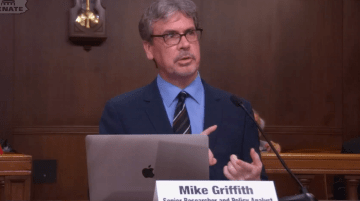LPI Senior Researcher and Policy Analyst Michael Griffith testified at the Pennsylvania General Assembly’s Basic Education Funding Commission Hearing on September 13, 2023. Here are his prepared remarks.
Chairs and Members of the Committee, thank you for the opportunity to appear before you today. My name is Michael Griffith, and I serve as a Senior Researcher and Policy Analyst at the Learning Policy Institute (LPI), an organization dedicated to advancing evidence-based policies in education to ensure equitable learning opportunities for all children. I'm here today to discuss two critical subjects: how states determine the foundation amount within their school funding formulas and the optimal allocation of K-12 education funding between state and local sources.
Foundation Formulas in Each State: States employ two primary distribution methods for K-12 funding. The first is through a foundation or base formula, and the second involves a resource allocation system. The latter, while once common, has lost favor due to its inflexibility in today's dynamic education landscape. Thirty-six states currently use foundation formulas, six state use resources allocation formulas, and the remaining six have funding systems that are unique to their states.
Illinois and Pennsylvania both use a modified foundation formula. These systems provide districts with a “hold harmless” amount of funding and distribute all new education funds through a foundation system.
What is a Foundation Formula: Foundation formulas serve as the cornerstone of K-12 education funding. These formulas commence by establishing a foundation amount, which theoretically covers the necessary funding to meet state standards for a general education student. This foundation amount is then adjusted through the application of student weights, designed to address the unique needs of student groups such as at-risk students, English language learners, and special education students. Foundation amounts can also be adjusted based on district characteristics (Size, cost-of-living, location, ect.)
States employ various methods to determine their foundation amounts, including research-based approaches, past year expenditures, reliance on educational inputs, or considering available funding. For example, Maryland has established its foundation amounts through commissions and comprehensive studies.
However, each method has its challenges, from clarity and time-consumption to cost considerations. Georgia, for instance, utilizes educational inputs to calculate its foundation amount, allowing policymakers to see precisely what state funding covers, but this method requires meticulous detailing and regular updates.
State Local Funding Split: Over the past century, there has been a significant shift towards greater state involvement in education funding. In the 1919-20 school year, states covered 83.2% of education funding, whereas today, that figure stands at 45.1%. In contrast, the percentage of state funding has increased from 16.5% to 47.5%.
Research doesn't prescribe a specific percentage for state funding, but it does underscore the relationship between increased state funding and greater equity in education. In the 2020-21 school year, 45.3% of K-12 public education funding came from state sources nationwide, compared to 37.4% in Pennsylvania.
Pennsylvania’s School Funding System: To illustrate, let's examine Pennsylvania's school funding system for the 2023-24 school year. Approximately 50.9% of state funding flows through the "Basic Education Funding" program, while 25.3% of these funds are distributed via the "Weighted Student Funding" program, accounting for 12.9% of the state's K-12 education funding and 4.8% of total education funding.
Conclusion: In closing, achieving greater equity within a state's school finance system can be attained through specific measures. Increasing the state's share of school funding, especially when channeled through primary funding formulas tailored to student and district needs, is a key step. Moreover, it's essential to ensure that state funding is directed toward districts and students in the most need.
